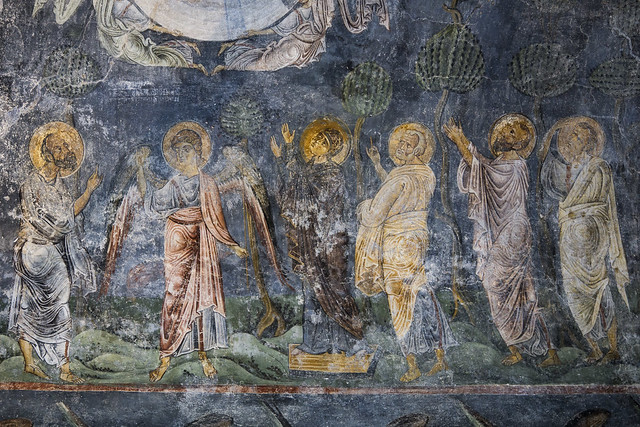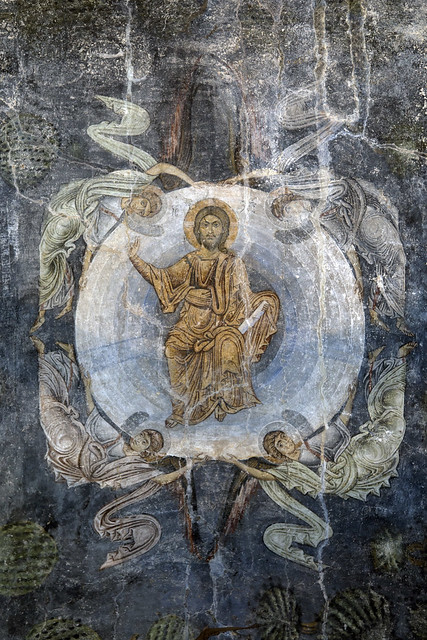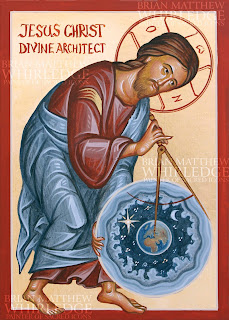 |
| Theotokos Perivleptos Church, Ohrid |
Today was a dream. I spent hours and hours in the presence of beloved icons and frescoes, I filled up over a third of a sketchbook, and I got to explore a beautiful old city.
Ohrid is known as the Balkan Jerusalem because of its importance as the gateway city for Slavic Christianity. It was here that the Bible and service texts were translated into Slavonic and the first Slavic archbishopric was established. This city had 365 churches before the Turkish yoke.
Theotokos Perivleptos Church
Photos were not allowed within Ohrid's churches, so the following photos of frescoes and icons are not mine.
Built in 1295, the Theotokos Perivleptos Church is one of the oldest surviving churches in Ohrid. This church survived because it wasn't the biggest or grandest church, and thus did not attract much attention. It was the primary parish church in Ohrid during the Ottoman period. It was built by the Byzantine military commander Progon Zgur, who was the son-in-law of the Roman Emperor Andronicus II Paleologus.

The frescoes in the church were painted by the preeminent medieval painters Michael and Evtychios. Their signatures are preserved, hidden in the frescoes. Serbian King Milutin visited this church and was so impressed by their work, he hired them to paint the many churches he built.

There is stylistic evidence to suggest Evtyches and Michael Astrapas were actually Slavs belonging to a local Ohrid school, rather than coming from Constantinople. Ohrid was such an important center of Slavic church life--there were thousands of monks here who were writing, painting, and developing church life.


This fresco of Saint Clement of Ohrid has always stood to me when I thought about the Perivleptos Church. It was such a joy to spend a few minutes with this fresco today!

The fresco cycle is highly detailed and narrative, telling life of Christ in the vaults and upper tiers of the walls. The life of the Theotokos is shown in detail around the perimeter walls in the middle tier. Standing saints are shown in the lowest tier, nearest to us. The frescoes are in remarkable condition. The church has been in continual use, so it has been well maintained. The frescoes were restored in the 20th century using the best techniques.
The Icon Gallery
The Icon Gallery is next door to the Perivleptos Church. When the Ottoman Turks destroyed churches or converted them to Mosques, many Christians took icons from the churches and hid them at home. Eventually they brought them to the Perivleptos church and hid them in the attic. When the church was being restored, this treasure trove of icons was discovered. The gallery was built to conserve and display them.
For me, the highlight of the day was being able to spend about half an hour praying and drawing in front of this icon of my patron, Saint Matthew. I've had a copy of this icon in my icon corner for over 15 years. This is the image that comes to mind when I think about my saint.
It was also awesome to spend some time studying this elegant icon of the Annunciation.
We left the icon gallery and began to tour the ancient Roman ruins of Ohrid and some general site-seeing. I love Roman ruins and old cities, but I came here for the icons, so I left the group and went back to the icon gallery, Perivleptos Church, and Saint Sophia Church. I was able to spend hours sketching and spending time with these unparalleled icons and frescoes.

I met up with the group again for lunch, next to Saint Sophia Church. We ate delicious trout from Lake Ohrid. While the others finished their lunch, I ran back up to the Perivleptos Church to have an extra half hour or so. I was winded, since it's a pretty steep climb from St. Sophia to Perivleptos. The name of the city "Ohrid" means something like "what a hill!" The city is built on a strategic hill peninsula that juts into the lake. I sketched in Perivleptos until the church closed at 15:00 (3pm) and they kicked me out. I walked back down the hill to Saint Sophia church. The timing was perfect--the group was entering the church as I arrived.
These are the picturesque but difficult stairs between Saint Sophia and Perivleptos.
Saint Sophia Church
I've referenced and studied Saint Sophia Church for years because of its exquisite and unique frescoes. It was so awesome to visit this church in person and to spend a few hours in this space.
Saint Sophia is dedicated to the Logos Jesus Christ, the Wisdom of God, rather than a holy woman named Sophia. A better translation in English would be Holy Wisdom, but the name Saint Sophia is so widely used for this church, I'm going to stick with it.
The Communion of the Apostles
For years, I've loved this fresco of the Communion of the Apostles. I've referenced it in my own work, and it was such a delight to spend time in front of it and sketch it on location.
Saint Eustathios of Antioch
Saint Sophia was the cathedral Church. It is a large three-aisled basilica. It probably never had a dome. It was built in the 11th century, before the great schism. This church is so unique because it contains the oldest extant Byzantine frescoes, dating about 1,000 years ago. The Orthodox churches generally favored mosaics for wall decoration until this time, and Greeks continued using mosaics for a couple more centuries. Fresco painting developed first as a Slavic expression of Orthodox iconography.
From the Ascension
Saint Sophia was converted to a mosque during Ottoman rule. The Turks plastered and/or whitewashed over the frescoes. Their existence was unknown until the mid-20th century when the Communist governent was using it as a concert hall (the acoustics are superb--I chanted a hymn in the church) the frescoes were discovered underneath the whitewashed walls. The Ottoman plaster and whitewash was removed to reveal these frescoes. They offer an unique glimpse into the earliest Byzantine fresco painting. Although the basilica is large, the frescoes are only in decent condition around the sanctuary. The rest of the church contains few extant frescoes.
I love the classical epxression of form preserved here.
Thanks to Father Ilya, we were able to see the Narthex, which is closed to visitors. The narthex is filled with frescoes in decent condition. The narthex is very unique. It is about as long as the church, but is situated cross-wise, so the entire structure is like a "T." The narthex has two stories, and the second story has an extrior porch (shown above).
The group continued the tour, but I remained in this incredible space. I spent close to two hours in Saint Sophia until they closed the church and kicked me out at 18:00 (6pm).
With all the important churches closed, I began my exploration of the winding streets of the old town of Ohrid.
I walked out to the picturesque St. John's church, perched out over the water.
I took a wooded trail back into town.
I ate a Greek salad at a waterfront restaurant. The vegetables are fresh and delicious here. I enjoyed painting the beautiful scenery before my dinner. After dinner, I walked along the waterfront and watched a folk ensemble perform traditional music and dance before retiring to the hotel to write this post. Tomorrow, we'll have an early start to see monasteries in the dramatic canyon setting, before returning to Serbia to visit important monasteries in Kosovo and Metohija.










































Comments
Post a Comment